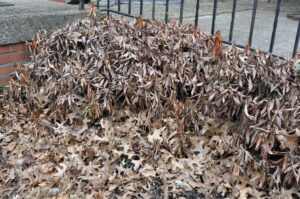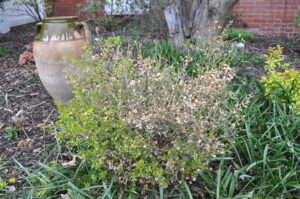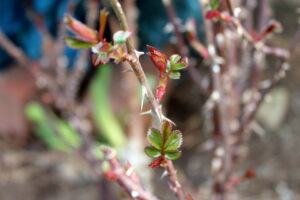How One of the Warmest Winters Ever Caused Some of My Worst Plant Damage Ever
May 16th, 2023
How could this be?

This is what winter did to my planting of sweetboxes.
After one of our warmest winters ever – including a January that was nearly 9 degrees warmer than average and a February that averaged 7.3 degrees above normal – my landscape looked like it had been to Alaska and back.
Most of my variegated boxwoods were the color of toast by the end of March.
A dwarf nandina, a leucothoe, an aucuba, a band of sweetbox, a trio of gold-variegated box honeysuckles, and a pair of Red Beauty hollies were in various states of brown with rings of fallen leaves at their feet.
A dwarf ‘Hedgehog’ cedar – an elegant new specimen going into winter – came out the back end completely brown and brittle. Ditto for that little osmanthus I got as a freebie at last year’s Philadelphia Flower Show.
The ‘Tonto’ crape myrtle I planted two seasons ago had nothing but brown, brittle branches and has died back to the roots.
Even my plenty-hardy roses suffered noticeably more branch dieback than usual.
You’d expect this kind of damage in a cold winter, like the kind of sub-zero ones we used to get… or that year the low went down to minus-22 degrees.
But when winter days are primarily in the 40s and 50s, plants should be safe and happy, right?
Not necessarily.
The explanation here is twofold.
One is the pair of nights we had right before Christmas when the lows at my house near Pittsburgh went down to minus-4.
All it takes is a single night into unbearable temperatures to harm a plant that isn’t genetically adapted to it.
We’re all familiar with what happens to a coleus or a tomato plant when temperatures first drop below freezing in fall. Those bow out almost immediately at 32 degrees.
Some, like camellias and photinias, can tolerate lows down into the teens, but they’ll generally croak by the time a night dips into the single digits.
Other species keep dropping out as the temperatures keep going down.

The most exposed top part of this gold-variegated boxwood has browned out from winter, but the inner, lower part fared slightly better.
I suspect most of my damage occurred Dec. 23 and Dec. 24. After that, it didn’t really matter what happened with the rest of winter.
The second issue has to do with consistency and timing.
Once plants go dormant to protect themselves heading into winter, they’re pretty good at staying protected so long as the plants “think” it’s still winter.
The problem happens when temperatures get warm enough long enough to fake plants into emerging prematurely from dormancy. When they start pushing out buds and little leaves before winter is really done, that growth can get zapped when the weather nosedives.
Nearly as harmful is when temperatures yo-yo wildly, hitting the 80s one fine March day but then going back under freezing the next night.
New and recently planted plants are particularly susceptible to all of these weather anomalies.
Since my entire landscape is under four years old – and planted in super-heavy black clay that seems to be the first stage of coal – it’s no wonder, really, that so many of my plants took a beating.
The good news is that plants try hard. They don’t want to die any more than you want to see your garden-center budget go down the drain.
And so lots of the evergreens push out new growth from dormant buds to replace the lost “evergreen” foliage, while others send up new shoots from the surviving roots to replace the branches that died above.
That’s what I’m seeing lately from a lot of my wounded plants now that the weather has warmed consistently.
Much of my evergreen injury in particular seems to have been to the foliage and branch tips. The inner and lower branches are largely alive and beginning to sport new growth.

It’s a good sign when new shoots poke out of suspect branches.
Some plants have recovered sooner than others. Thank you hollies, box honeysuckle, roses, azaleas, and osmanthus. The crape myrtle finally started sending up new shoots from the base just last week.
On the other hand, others are testing my patience. I’m still seeing no signs of life from a pair of variegated boxwoods, that band of sweetbox, and the aucuba.
Most of my bigleaf hydrangeas are still showing way more lifeless branches than usual, although new growth is generating from low on the plants. (That doesn’t bode well for this year’s bloom.)
I’m still watching and waiting and hopeful that the recovery will be better than expected. I’ve learned not to dig anything for dead at least until after Memorial Day.
Even then, lifeless plants have to fail three tests before being “shovel-pruned:” 1.) no green when I scrape off small bits of bark; 2.) branches are all breaking instead of bending, and 3.) there’s no sign of new shoots coming up from around the base.
Fingers crossed.







